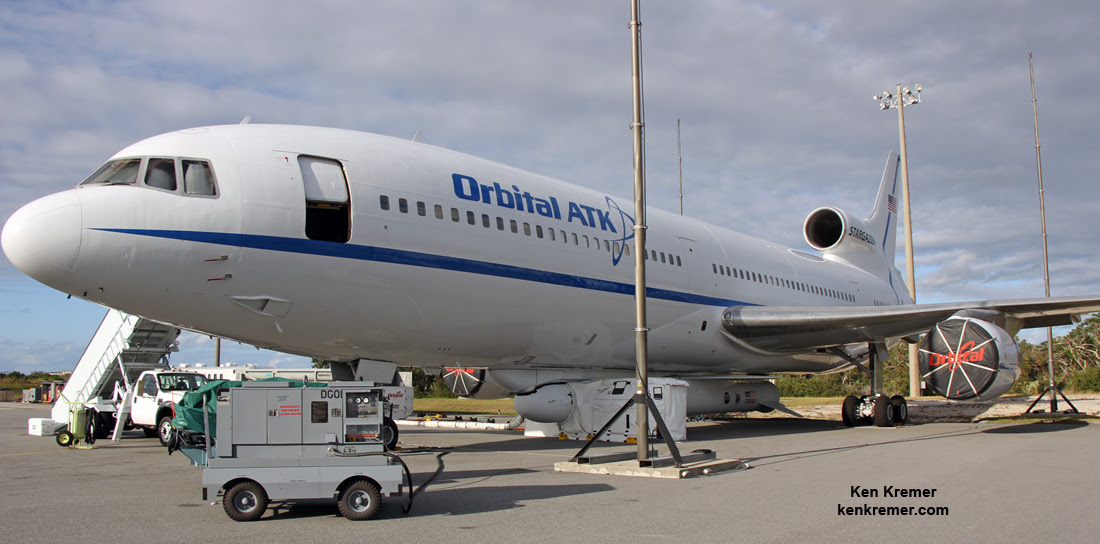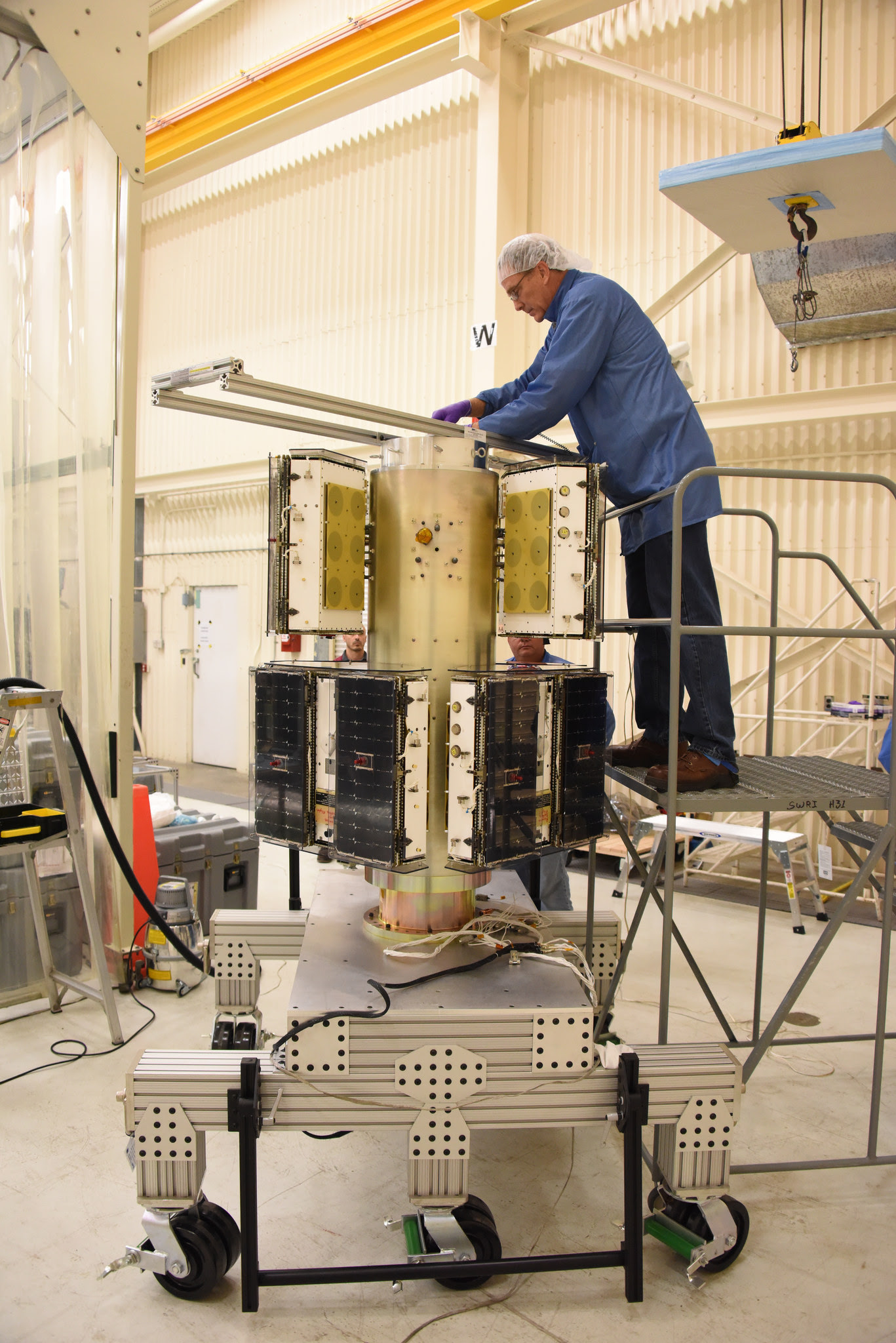CYGNSS Constellation of Hurricane Monitoring MicroSats Set for Dec. 12 Launch – Watch LiveKen Kremer द्वारा |

Artist's concept of the deployment of the eight Cyclone Global Navigation Satellite System (CYGNSS) microsatellite observatories in space. Credits: NASA
KENNEDY SPACE CENTER, FL - An exciting new chapter in hurricane monitoring and forecasting intensity prediction is due to open Monday morning at NASA’s Kennedy Space Center when a new constellation of microsatellites dubbed CYGNSS are slated to be deployed from an air-launched Orbital ATK Pegasus XL rocket.
The fleet of eight identical spacecraft comprising the Cyclone Global Navigation Satellite System (CYGNSS) system will be delivered to Earth orbit by an Orbital ATK Pegasus XL rocket.
The Pegasus/CYGNSS vehicle is attached to the bottom of the Orbital ATK L-1011 Stargazer carrier aircraft.
“The CYGNSS constellation consists of eight microsatellite observatories that will measure surface winds in and near a hurricane’s inner core, including regions beneath the eyewall and intense inner rainbands that previously could not be measured from space,” according to a NASA factsheet.

The Orbital ATK L-1011 Stargazer aircraft at the Skid Strip at Cape Canaveral Air Force Station in Florida. Attached beneath the Stargazer is the Orbital ATK Pegasus XL with NASA's CYGNSS payload on board, being processed for launch on Dec. 12, 2016. Credit: Ken Kremer/kenkremer.com
CYGNSS is an experimental mission to demonstrate proof-of-concept that could eventually turn operational in a future follow-up mission if the resulting data returns turn out as well as the researchers hope.
The Pegasus XL rocket with the eight observatories are tucked inside the nose cone will be air-launched by dropping them from the belly of Orbital’s modified L-1011 carrier aircraft, nicknamed Stargazer, after taking off from the "Skid Strip" runway at Cape Canaveral Air Force Station in Florida.
If all goes well, the rocket will be dropped from Stargazer’s belly for the launch currently planned for Monday, Dec. 12 at 8:24 a.m. EST.
Five seconds after the rocket is deployed at 39,000 feet, the solid fueled Pegasus XL first stage engine with ignite for the trip to low earth orbit.
The launch window lasts 1 hour with the actual deployment timed to occur 5 minutes into the window.
NASA’s Pegasus/CYGNUS launch coverage and commentary will be carried live on NASA TV - beginning at 6:45 a.m. EDT
You can watch the launch live on NASA TV at - http://www.nasa.gov/nasatv
Live countdown coverage on NASA's Launch Blog begins at 6:30 a.m. Dec. 12.
The weather forecast from the Air Force’s 45th Weather Squadron at Cape Canaveral is currently predicting a 40% chance of favorable conditions on Monday Dec 12.
The primary weather concerns are for flight through precipitation and cumulus clouds.
The Pegasus rocket cannot fly through rain or clouds due to a negative impact on the thermal protection system.
In the event of a delay, the range is also reserved for Tuesday, Dec. 13 where the daily outlook increases significantly to an 80% chance of favorable weather conditions.
After Stargazer takes off from the Skid Strip early Monday morning around 6:30 a.m. EST, it will fly north to a designated point about 126 miles east of Daytona Beach, Florida over the Atlantic Ocean. The crew can search for a favorable launch point if needed.
The rocket will be dropped for a short freefall of about 5 seconds. It launches horizontally in midair with ignition of the first stage engine burn, and then tilts up to space to begin the trek to LEO.
The CYGNSS constellation works in coordination with the Global Positioning System (GPS) satellite constellation.
The eight satellite CYGNSS fleet “will team up with the Global Positioning System (GPS) constellation to measure wind speeds over Earth's oceans and air-sea interactions, information expected to help scientists better understand tropical cyclones, ultimately leading to improved hurricane intensity forecasts.”
"Forecasting capabilities are going to be greatly increased," NASA Launch Manager Tim Dunn said at the prelaunch media briefing at the Kennedy Space Center on Dec. 10. "As a Floridian, I will really appreciate that, certainly based on what we had to do this fall with Hurricane Matthew."
Indeed the CYGNSS launch was delayed by Hurricane Matthew, just like the NASA/NOAA GOES-R launch was also delayed from early to mid-November by the deadly Cat 4 storm.
The nominal mission for CYGNSS is two years but the team says they could potentially last as long as five years or more if the spacecraft continue functioning.
Pegasus launches from the Florida Space Coast are infrequent. The last once took place over 13 years ago.
Typically they take place from Vandenberg Air Force Base in California or the Reagan Test Range on the Kwajalein Atoll.
The Space Physics Research Laboratory at the University of Michigan College of Engineering in Ann Arbor leads overall mission execution in partnership with the Southwest Research Institute in San Antonio, Texas.
The Climate and Space Sciences and Engineering Department at the University of Michigan leads the science investigation, and the Earth Science Division of NASA's Science Mission Directorate oversees the mission.
Stay tuned here for Ken's continuing Earth and Planetary science and human spaceflight news.


No comments:
Post a Comment